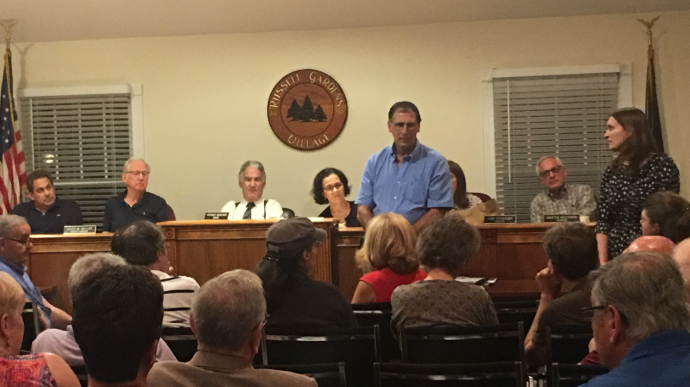Russell Gardens residents flooded Village Hall in response to news that a groundwater plume is expected to reach their village within the next two years, as it continues on its path northwest to the Long Island Sound.
The underground plume originates from 1111 Marcus Ave., the former location of Unisys, a manufacturing company. The facility was acquired by the global defense company Lockheed Martin when it purchased Unisys in 1996. Lockheed Martin sold the property in 2000.
As the former owner of the site, Lockheed Martin is responsible for the payment and management of the groundwater cleanup under the supervision of the state Department of Environmental Conservation and the water districts of Manhasset-Lakeville and Great Neck North.
Representatives from Lockheed Martin attended Thursday’s meeting to address residents’ concerns about the plume.
The primary contaminant identified in the plume is trichloroethene, or TCE, a degreaser that was commonly dumped when the facility was owned by Sperry in the 1940s.
Glenda Clark, Lockheed Martin’s project lead on the site clarified that “this isn’t new contamination, this is contamination that is spreading because of the natural flow of groundwater.”
Eric Weinstock, principal scientist contracted by Lockheed Martin, explained that in this area of the island, groundwater tends to spread northwest which is why it is projected to reach Russell Gardens from Lake Success.
“The wells of most concern now are the Cutter Mill Road wells,” he said, “and those wells have already been impacted by Stanton Cleaners.”
According to the Environmental Protection Agency’s website, the main contaminant from the Stanton Cleaners’ plume, a quarter-acre plume located at 110 Cutter Mill Rd., is also trichloroethene.
Lockheed Martin representatives said they will install groundwater monitors on Tain Drive which will be used to alert them when their contamination reaches the area.
“We recognize what is happening and we recognize that this is our plume so we are going to pay for your treatment as soon as our plume hits,” said Clark.
Trustee Matthew Ellis questioned whether there would be health risks for residents when these contaminants reach Russell Gardens.
“At the moment the groundwater is so deep there is no risk to human health and that is because we are treating the water when it is pulled up,” Clark said.
Weinstock also explained that the existence of the groundwater plume under the village does not impose a risk to residents. “The only way it can have an impact is if there is an exposure, you would either have to breathe in the vapors or get it on your skin,” he said.
This exposure could only happen if someone drilled 300 feet down in Russell Gardens, Clark added, and “they would need a permit and we would be notified.”
The groundwater plume has already affected supply wells in the Manhasset-Lakeville Water District, which provides the drinking supply for Russell Gardens.
Lockheed Martin operates two water treatment centers on and off the Marcus Avenue facility. The on-site treatment center treats 850 gallons of groundwater per minute, while the off-site location treats 500 gallons of groundwater per minute.
Clark said that since the project began in the early 2000s, about 60 percent of the contamination has been removed.
Groundwater flowing from 1111 Marcus Ave passes through both treatment sites before encountering any supply wells, Clark said.
“We are cleaning [the groundwater] and then re-injecting it as clean,” Clark said. “Essentially where it is going to go is to another drinking water well where there is treatment to get treated again.”
According to the water district’s website, “three wells have been removed from service as part of the off-site remediation plan associated with the former Lockheed Martin site in Lake Success.”
The drinking supply is monitored by multiple independent laboratories, Weinstock said.
State Sen. Elaine Phillips (R- Flower Hill), who also attended the meeting, reassured residents that the United States Geographical Survey is monitoring wells “all across Long Island from Jamaica, Queens all the way to the end of the island” for saltwater intrusion “at the same time as they are monitoring for contaminants too.”
“If they see anything, there is another way they will catch it,” she said.
Lockheed Martin projects they will have the contamination cleaned up by 2044.

